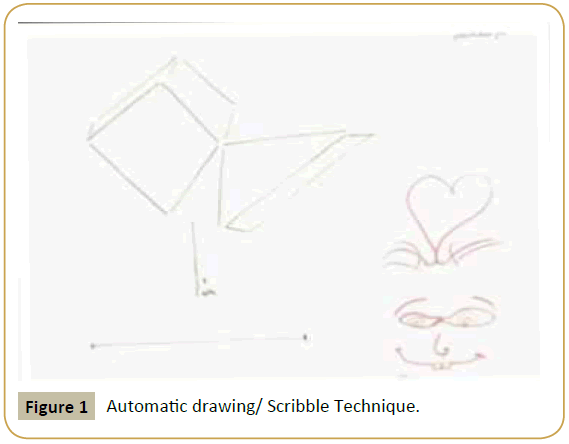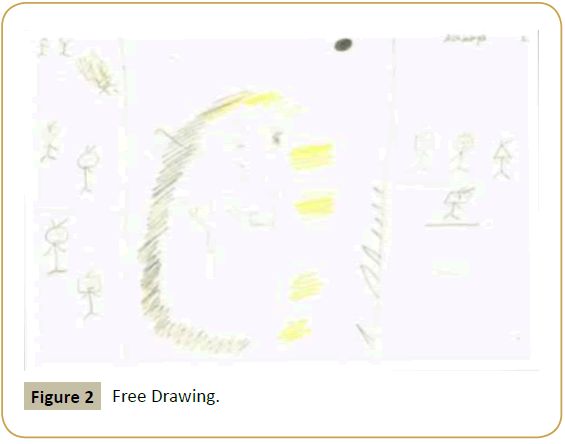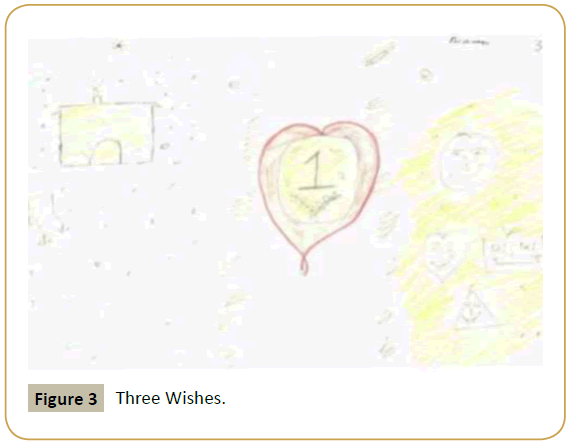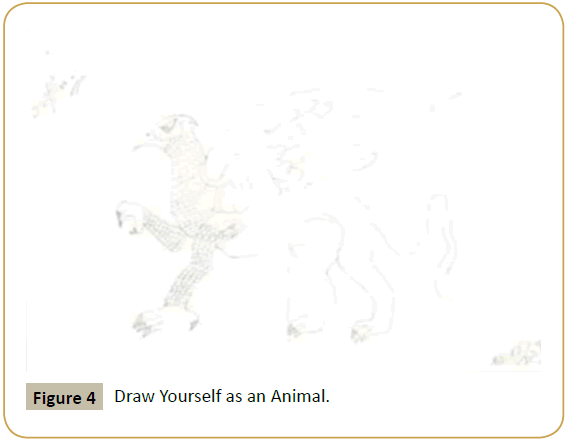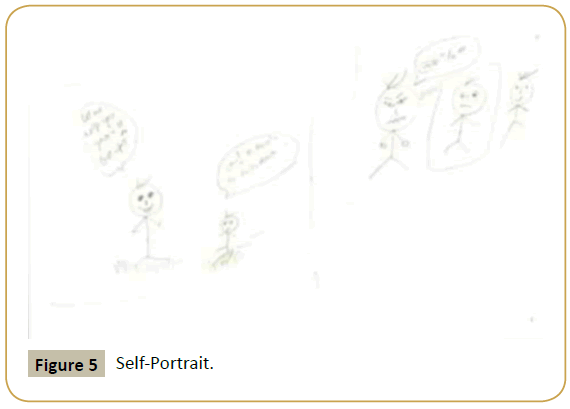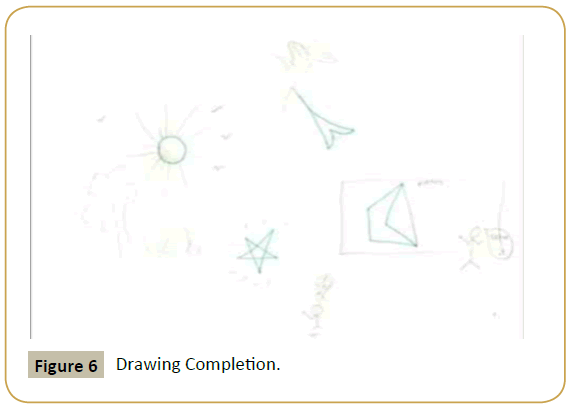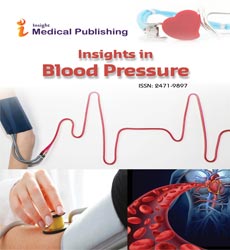Assessing Self Using Art Therapy: A Case Analysis
Nishi Tripathi
Department of Psychology, Chitamber School of Humanities and Social Sciences SHIATS, Allahabad, India
- Corresponding Author:
- Nishi Tripathi
Associate Professor and Head, Department of Psychology
Chitamber School of Humanities and Social Sciences
SHIATS, Allahabad, India
Tel: 0532-2466055
E-mail: tripathi_nishi@yahoo.com
Received Date: October 29, 2015; Accepted Date: November 01, 2015; Published Date: November 08, 2015
Citation: Tripathi N. Assessing Self Using Art Therapy: A Case Analysis. Insights Blood Press 2015, 1:1.
Abstract
The study conducted discusses the use of art therapy at a University counseling center as an additional approach to treating clients. Like all young adults, adolescents need to cope with psychological and psychosocial a change that is connected to the development of an independent life. Coupled with the stressors of University, individuation, academic pressures, and personal and professional goal attainment, emotional regulation can become difficult. The research presented explains the prevalent mental health issues that are being diagnosed on University campus and the definition and benefits to using art therapy as a way of expressing feelings and thoughts. The purpose of the present research was to assess whether or not students and faculty see a need to incorporate art therapy into traditional psychotherapy. This study examines mental health issues in colleges and the effects that they presume on students. The literature reviewed supports the use of different art Medias as a means of exploring an individual’s inner self. The study defines art therapy techniques as a mode of treatment to use in conjunction with psychotherapy. The study also focused on how art therapy could prove to be useful in combating the mental illnesses that are prevalent in higher institutions. From the results it appears that the need and interest for the use of art therapy in a counseling center was supported. The study also found that most all the participants agreed with the treatment benefits of art therapy. An open psycho-educational art group in the college setting could be a useful approach to reducing depression and anxiety and providing students with coping skills.
Keywords
Art therapy; Psychological, Psychosocial; Literature; Sculpture; Self-expression
Introduction
Art therapy is a form of projective technique that uses the creative process of art making to improve and enhance the physical, mental and emotional well-being of individuals of all ages. It is based on the belief that the creative process involved in artistic self-expression helps people to resolve conflicts and problems, develop interpersonal skills, manage behavior, reduce stress, increase self-esteem and self-awareness, and achieve insight. Art therapy integrates the fields of human development, visual art (drawing, painting, sculpture, and other art forms), and the creative process with models of counseling and psychotherapy. According to British Association of Art Therapists, “Art therapy is a form of psychotherapy that uses art media as its primary mode of communication [1]. It is practiced by qualified, registered Art Therapists who work with children, young people, adults and the elderly. Clients who can use art therapy may have a wide range of difficulties, disabilities or diagnoses. These include, for example, emotional, behavioral or mental health problems, learning or physical disabilities, life-limiting conditions, brain-injury or neurological conditions and physical illness. Art therapy may be provided for groups, or for individuals, depending on clients’ needs. It is not a recreational activity or an art lesson, although the sessions can be enjoyable. Clients do not need to have any previous experience or expertise in art”.
Kramer was the first person to champion this school of thought [2]. Kramer emphasized the healing qualities of art making, and was concerned with artistic quality. Art therapy also helps people to discover things about themselves based on what they draw. Along with Art therapy, it is necessary to counsel children so that they are able to overcome their issues & fears. Art therapy & counseling can together help a child in enhancing their capacity to deal with problems and would eventually lead to their optimal development. Naumburg believed that this was the best way to utilize art therapy [3]. In this way, the art therapist uses art as a window into the subconscious of the patient, and from there can attempt to figure out the underlying problems that the patient may be suffering from. It can be risky to look into art too closely, but in the case of children, who may not have the words to express how they are feeling; it is very beneficial to use art as a mode of expression. Two of the procedures warrant additional attention. The first one involves the use of art or drawing as an assessment tool, procedure clinicians have used for some time. The second is the use of clinical interview with children, adolescents and parents.
Drawings or Art
Drawings or art can be used in both standardized and nonstandardized assessment procedures. One standardized procedure is the Good enough-Harris Dearing Test [4]. This test requires children and adolescents to make a picture of a man or woman and a picture of themselves. Another commonly used standardized test is the House-Tree-Person in which children and adolescents first draw a house, then a tree and last a person [5]. Most recently, Knoff and Prout developed the Kinetic Drawing System for family and School, Children and adolescent, draw one picture of their family and another that relates to school [6].
This test assesses important relationship at home and school. Stabler provides information on the non-standardized use of drawings with children and adolescents. He notes that drawings can be us to obtain an estimate of a child or adolescent’s cognitive and psychosocial development and level of maturity [7].
Purpose of the Study
The purpose of this research was to assess on how art therapy could prove to be useful in combating the mental illnesses that are prevalent in higher institutions. This research is important because stress and anxiety affect the lives of many students and can have strong influences on students psychologically, emotionally, physically and academically. It is important for counselors to learn how they can better help students and to build coping mechanisms and resiliency. Art therapy could be effective as it is proven to be a good tool when working with mental health issues. It is also a versatile approach and is cost and time effective. The present research was planned to study the impact of Art therapy and Counseling on adolescents undergoing stress and anxiety and help them to deal effectively with their problem and issues through art therapy and counseling. It also aimed to help adolescents release their tension with the help of training in muscle relaxation technique.
Sample
Client ‘A’ was purposely selected for the purpose of the study. A case study method was adopted to focus on in-depth analysis of an individual. The assessment involved individual who received services at the university counseling center. Participation in the assessment was voluntary and anonymous. The participant used the counseling services and was about 18 year’s old female, studying in class 12th.
Materials
Participant was given a survey to measure the need and desire of art therapy in the counseling center. The needs assessment is entitled “Using Art Therapy to Express Your Self” and used a yes, no, or not applicable measure. There was also a section for comments to allow participant to express her thoughts on art therapy. The needs assessment test was developed by the researcher.
Procedure
An orientation talk was conducted for the participant to make her aware about the objectives of intervention program, its impact and benefits to the individual. The purpose of Art Therapy and Counseling was explained to the participant and was briefed about the process Art Therapy and Counseling to aware about the concept of stress and anxiety and its related problems. Pre-stress anxiety test questionnaire was administered on the participant and was encouraged to undergo art therapy and counseling to overcome her issues and problems. She was also informed about ethical considerations involved in this process and assurance was given to them regarding confidentiality of their information.
Collection of Data
The data was collected through both quantitative and qualitative tools. The scores of pre and post stress and anxiety test questionnaire served as quantitative data whereas observation of adolescents and analysis of their art work served as qualitative data.
Pilot Study Data Analysis
The data analysis of pilot study was done through comparing the pre and post stress score of the participant and inferences were made on the basis of stress score and artwork of participant. It was observed that art therapy and counseling had a significant impact on participant as it reduced the stress and anxiety level of participant.
Summary of the Case Analysis
The research was conducted to assess the effectiveness of Art therapy and Counseling on participant undergoing stress and anxiety. The obtained data has been analyzed by assessing the drawings made by the participant and pre & post stress test questionnaire filled by her. The case summary wise data was as follows: (For maintaining the confidentiality of adolescents, their names have been changed).
Behavioral Observation
Client A was an 18 year old girl studying in class XII in ABC school, Allahabad came to the counselor in realm of personal social counseling. She belongs to an upper middle class socio-economic background. Her family comprise of five members including her father, mother, elder brother, grandmother and herself. Her father is a Chemical Engineer and mother is a housewife. She likes to listen to music and her favorite subject is English.
Client “A” mentioned that her mother does not keep well and has been diagnosed with depressive disorder. She stated that she thinks that she is suffering from Truman’s syndrome. She feels that her friends are watching her through a camera all the time and this makes her very conscious and thus she restricts herself in participating in various activities. She feels negativity all around and is unable to cope with life. She mentioned that she is very short tempered and her intense anger leads her to cut her hand. She further stated that because of all these issues, she tried to commit suicide when she was in 6th standard.
Client “A” appeared to be very stressed and sad when she came to the counselor. Her class teacher also referred her to the counselor.
Client A’s pre-stress test questionnaire scores revealed that she has high stress (score 90). In view of the nature of the problem, art therapy and counseling were conducted on the client to help her overcome her issues.
Art Therapy
The entire process of Art Therapy was divided into four parts:
1. Assessment
2. Treatment in the Beginning
3. Mid-phase of treatment
4. Termination
Assessment
The main objectives of Assessment were:
• To build a psychological climate of warmth, acceptance, trust and empathy so that the client feels free to talk about her problem.
• To gather information about client’s family.
Outcome
Client A was very restless when she came to the counselor but as the session progressed she felt comfortable. She reported that from the last 5-6 years she feels that her friends are always watching her through a camera. She mentioned that she thinks that this world is not made for her and therefore she has made an imaginary world for herself that consist of all those people who are close to her and where only love & positivity exist. She discussed about her short-tempered behavior and mood swings. She mentioned when she gets upset she cuts her left hand and after cutting them she feels relaxed.
She further reported that she keeps very upset because of her mother’s ill health. Her mother has been diagnosed with depressive disorder and as a result the environment at home is quite disturbing.
Researcher’s Observation
Client “A” looked very shabby and was very restless to discuss her issues. She continuously fiddled with her finger while discussing her issues. And most of time she was looking at the roof while talking.
In the next session of assessment, the objectives were:
• To explore client’s relationship with her father and brother.
• To administer pre stress test questionnaire on the client.
Outcome
In this session, client A’s relationship with her father and brother was explored. She mentioned that she shares a good relation with her father and said that he remains very upset because of her mother’s health. She told that her brother does not stay with them because of academic reasons. After this, she was given the Stress test questionnaire and was motivated to fill it accurately.
Treatment in the Beginning
Objectives
• To orient the client about Art therapy.
• To teach relaxation technique to the client.
Outcome
In this session, client A was oriented about Art Therapy and its features. She was quite amazed to hear about such a therapy and was initially hesitant to indulge in it. But, she was motivated and encouraged by telling her that this therapy does not focus on one’s artistic accomplishment but rather self-expression of the individual.
After this, deep breathing relaxation technique was taught to client A so that she can control her anger and increase her concentration.
Mid-phase of treatment
The main objectives of this phase were:
• To administer various techniques of Art therapy along with personal-social counseling sessions.
• To help the client relieve her tensions with the help of training in muscle relaxation.
Outcome and analysis
In this phase, several techniques of Art therapy were administered on the client, which was followed by Personal social counseling. The analyses of several techniques are as follows:
The client A undertook the following techniques one by one:
Session 1: Automatic Drawing (also known as the Scribble Technique)
In this, the client was asked to relax and begin to make draw free lines or scribbles on paper. After a while the client was instructed not to remove her pen from the paper until the exercise is over. Automatic drawing is an excellent way for the client to let down their guards.
Outcome
In this task, client A initially made several lines and then made a 3-D face out of it. It was very interesting to see how she made this face. When told to make a figure without removing the pencil, she made a heart and a face. This activity was basically given to help the client A to remove her nervousness related to Art therapy and to make her more comfortable (Figure 1).
Session 2: Free Drawing
In this, the client “A” was motivated to express herself freely and not to worry about planning the drawing. This technique is very useful because the images that the client creates are often mirrors into the person's present problems, strengths and weaknesses. At the end of the free hand drawing, the client was asked to share and explain what she drew about.
Outcome and Analysis
In this drawing, client A made her own self within a boundary. On the top of left hand side, she drew a camera from where she feels her friends watch her. Inside the boundary, she made a black circle that depicts her imaginary world. She also portrayed positive and negative energy which she feels she posses. She mentioned that her positive energy is declining whereas negative is increasing. She also made nails (symbol of pain) towards the right side of picture that she thinks are coming from her parent’s side.
Client A mentioned that after drawing her issues, she could relate herself to her thoughts. She told that she felt very good and peaceful after making this drawing. This task gave an outlet to client A to portray her issues that she had not discussed before with anyone (Figure 2).
Observation
Client A took lot of time to make this drawing. She looked quite calm while drawing.
Session 3: Three Wishes
In the three wishes technique, client A’ was asked to portray her three or more wishes:
Outcome and analysis
1st wish: In this drawing, she drew a house which consists of a chimney. The snow is falling outside the house and the sun is shining bright in the sky.
2nd wish: For the second wish, she made one rupee coin encircled by a heart.
3rd wish: In this drawing, she made four smiling faces.
After client “A” completed the drawings, she was asked to explain what she drew and then a discussion followed focusing on the strength of the wish and whether or not these wishes are attainable. While explaining the 1st wish, client “A” mentioned that she really wish to have a house at a lonely place where snowfall always takes place. She wants that her dream house should consist of antique pieces and a chimney to keep her house warm and cozy. The second wish of client “A” was that she should excel in whatever she does like sports, studies and so on. She wants that she should be very rich and famous. Her third wish is that her home environment should improve so that everybody is happy including her parents, brother, grandmother and herself.
After explaining her drawings, she was asked to tell which all wishes she think are realistic and attainable. She stated that she thinks that her 1st wish is attainable but at a later stage. For 2nd wish, she is doubtful as it requires lot of hard work and she does not like to put much effort for any task. She mentioned that her third wish is unattainable because of her mother’s deteriorating health (Figure 3).
Observation
While explaining 1st wish, client A was very excited and happy. But as she came towards the last wish she seemed very upset and sad.
Session 4: Draw yourself as an Animal
In this task, client A was asked to draw herself as any kind of animal, or as the animal she see herself as most similar to.
Outcome and analysis
In this task, client A drew a Griffin. Client A mentioned that she drew Griffin because it is a majestic animal and is loyal & trustworthy and she feels that she too has these qualities. After this, the counselor asked client A if she liked comparing herself to an animal. She mentioned that it was a great experience to first think and then draws an animal to which she thinks she resembles (Figure 4).
Observation
Client A took lot of time to make this drawing. It seemed that she thoroughly enjoyed making this drawing.
Session 5: Progressive Muscle Relaxation Technique
The main objective of this session was to help client A relieve her tensions with the help of progressive muscle relaxation technique. The counselor instructed the client A to do progressive muscle relaxation in the following way:
• Take a few minutes to relax, breathing in and out in slow, deep breaths.
• When you’re relaxed and ready to start, shift your attention to your right foot. Take a moment to focus on the way it feels.
• Slowly tense the muscles in your right foot, squeezing as tightly as you can. Hold for a count of 10.
• Relax your right foot. Focus on the tension flowing away and the way your foot feels as it becomes limp and loose.
• Stay in this relaxed state for a moment, breathing deeply and slowly.
• Now shift your attention to your left foot and squeeze it as tightly as you can. Hold for a count of 10. Relax your left foot and focus on the tension flowing away and the way your foot feels as it becomes limp and loose.
In the same way, instructions were given to relax legs, abdomen, back, neck and face.
Outcome
Client A mentioned that she felt very fresh and relaxed after undergoing this relaxation technique.
Session 6: Self-Portrait
In this technique, client “A” was asked to portray herself. This technique was aimed to help her gain complete awareness of her personal needs and body image.
Outcome and analysis
In this drawing, client A portrayed her two different selves. In the first one, she portrayed herself as being very helpful and kind to people. In the second picture, she portrayed herself as a short tempered person, who does not think before speaking and hurt others.
While discussing about the drawing, client A mentioned that she feels that her bad quality is being overpowering the good one. She realized that she needs to control her anger to continue her cordial relationships with people around (Figure 5).
Observation
Client A seemed very enthusiastic while making the drawing. She was frowning while making her short tempered picture.
Session 7: Drawing Completion
In the drawing completion technique, client A was given a piece of paper that already had few simple shapes on them. She was asked to use these shapes as a starting point and make a picture out of it.
Outcome and analysis
From the first shape-circle, client A made a Sun along with tress, grass and birds. From the second shape she made a flower bud. From third, she drew her own self and a star. And from the last figure she made a blackboard. When asked the reasons for making such shapes she mentioned that she made Sun because she likes bright sunny days, she made star because she want to go there, a bud because it is a symbol of freshness & calmness. Out of all these figures, she loved making a bud (Figure 6).
Session 8: House-tree-person
In this task, the client was asked to depict a house, tree and a person in one picture. After completing the drawing, the client is faced with the task of relating the human figure to the other two common environmental features.
Outcome and analysis
In this task, client A made a house consisting of a chimney, a tress right outside the house with a bird’s nest and a person walking towards the house.
When asked to explain the drawing, she mentioned that she wishes to have a small house at a place where snow falls all the time and where greenery is there. When asked to relate the person with the house and tree, she stated that she has portrayed her best friend here and she wish that he should keep coming to her house. And as far as the tree is concerned, she wants that birds should make their nest on it (Figure 7).
Observation
It seemed that client A enjoyed making this drawing. In this drawing she portrayed her same wish of having a small house as she did in Three Wishes Techniques task.
Termination
Objectives
• To discuss the outcomes of Art Therapy.
• To terminate counseling sessions.
• To administer post stress test questionnaire on the client.
Outcome
The client came voluntarily for counseling with her irrational belief that she has Truman’s syndrome. With the help of cognitive interventions the counselor was able to challenge her irrational beliefs. The client was very stressed out when she came for counseling so before starting the therapy she was taught deep breathing relaxation technique so that she could cope with her stress in a better way.
After completing all the tasks of Art Therapy, client A was asked how she felt after undergoing Art therapy & Counseling sessions. She stated that she was quite happy and content with the therapy & sessions. She told that she could never imagine that she would see so many changes in herself because of this therapy. ‘A’ mentioned that she feels that she know herself better now. She has realized that her anger causes lot of problems for her and other people and so she has now started controlling her anger with the help of anger management techniques. Most importantly, she mentioned that she no longer feel that someone is watching her through a camera. She feels free and happy now. After this, the counselor informed client A about successful completion of Art Therapy. She was informed about the termination of Art Therapy and counseling sessions and was encouraged to fill the post stress test questionnaire accurately. Client A thanked the counselor for helping her resolve her issues and beliefs.
Evaluation
The client came voluntarily for counseling with stress and anxiety. This case was a challenge for the counselor as the client was very adamant that she has read about this type of problem and knew that she is undergoing it. With the help of traditional art therapy the researcher was able to reduce her stress and anxiety. The client was very stressed out when she came for counseling so before starting the therapy she was taught deep breathing relaxation technique so that she could cope with her stress in a better way. Art therapy seemed to be very helpful in this case. After portraying her thoughts on paper, the client realized that it was her irrational belief that people are watching her through a camera. She realized that in reality nothing like this is happening. Individual counseling along with Art Therapy helped client A to resolve her issues. Her post Stress test score indicate that she has below average stress (score 37). There are many case studies in the literature on the use of art therapy to reduce trauma symptoms and some proposals for art therapy treatment protocols for PTSD in children and adults [8-11]. Arnheim examined mental processes used in art making that art therapists believe may be involved in art therapy and discussed how visual perception corresponds to visual thinking [12]. Cognitive operations are not divorced from perception. Knowledge is built from the environment through the senses; the act of perceiving things visually is directly tied to the way one thinks about them. Exploring, abstracting, and problem solving are all processes of higher level thinking that depend heavily on perception. Given art’s reliance on perception and the senses, Arnheim postulated that art could be used to facilitate problem solving if it is true that visual perception is equivalent to visual thinking. The results of the present research indicate that art therapy would be beneficial to helping people express their emotions; it would have a positive impact on individuals [12].
Limitations
Although from the results of this study one could infer that there is an overwhelming interest and need for art therapy, there were many limitations to the study. First, the study was done with only one individual. In order to generalize the results, a larger sample size would have been better.
Secondly, considering the possibility of survey duplication by the same participant, a control for this must be met to account for this.
Implications for Counseling Practice
This study provides a greater understanding for the need and interest in art therapy as an alternate approach to addressing mental health concerns. First, from the results, one can infer that student’s are willing to support the use of art therapy. Therefore, college counselors and students can recognize the usefulness of this time effective method of counseling. The result of this study also informs counselors about the types of stressors that adolescents face in today’s society. With this knowledge, counselors can better identify students experiencing excessive stress and tailor counseling interventions and art therapy to address the problems.
Recommendations for Further Study
In order to better establish the need and interest of using art therapy as an additional approach, this study needs to be replicated with an increased number of participants, be screened for duplicate survey results and attach additional literature on the benefits of art therapy and mental health issues. This would allow one to sort out whether it is the lack of understanding and small population, rather than other factors like minimal information and a small sample, that underlies to the percentage of students who did not recommend or found that this approach was not relatable. This implies that parents need to be constantly aware of the important role that they play in nurturing of adolescent self-esteem.
Conclusion
The purpose of the present study was to examine on how art therapy could prove to be useful in combating the mental illnesses that are prevalent in higher institutions. From the results it appears that the need and interest for the use of art therapy in a counseling center was supported. Thus, Art therapy is a form of projective technique that uses the creative process of art making to improve and enhance the physical, mental and emotional well being of individuals of all ages. It is based on the belief that the creative process involved in artistic self-expression helps people to resolve conflicts and problems, develop interpersonal skills, manage behavior, reduce stress, increase self-esteem and selfawareness, and achieve insight. Art therapy integrates the fields of human development, visual art (drawing, painting, sculpture, and other art forms), and the creative process with models of counseling and psychotherapy.
The study also found that most all the participants agreed with the treatment benefits of art therapy. An open psycho-educational art group in the college setting could be a useful approach to reducing depression and anxiety and providing students with coping skills.
References
- British Association of Art Therapists (2011) Code of ethics. London: Author.
- Kramer E (2002) on quality in art and art therapy. American Journal of Art Therapy 40: 218-222.
- Naumburg M (2001) Spontaneous art in education and psychotherapy. American Journal of Art Therapy 40: 46-64.
- Harris DB (1963) Children's drawings as measures of intellectual maturity. New York: Harcourt, Brace & World, Inc.
- Buck J (1981) The HTP technique, a qualitative and quantitative scoring method. Journal of Clinical Psychology Monograph, Supplement 5: 1-120.
- Knoff HM, Prout HT (l985) Terminating students from professional psychology programs. Professional Psychology: Research and Practice 6: 789-797.
- Stabler JR, Johnson EE (1972) The meaning of black and white to children, International Journal of Symbology: 3.
- Rankin AB, Taucher LC (2003) A task-oriented approach to art therapy in trauma treatment. Art Therapy: Journal of the American Art Therapy Association 20: 138-147.
- Raymer M, Mcintyre BB (1987) an art support group for bereaved children and adolescents. Art Therapy: Journal of the American Art Therapy Association 4: 27-35.
- Sweig T (2000) Women healing women: Time-limited, psychoeducational group therapy for childhood sexual abuse survivors. Art Therapy: Journal of the American Art Therapy Association 17: 255-264.
- Collie K, Backos A, Malchiodi C, Spiegel D (2006) Art therapy for combat- related PTSD: Recommendations for research and practice. Art Therapy: Journal of the American Art Therapy Association 23: 157-164.
- Arnheim R (1969) Visual thinking. Berkeley CA: University of California Press.
Open Access Journals
- Aquaculture & Veterinary Science
- Chemistry & Chemical Sciences
- Clinical Sciences
- Engineering
- General Science
- Genetics & Molecular Biology
- Health Care & Nursing
- Immunology & Microbiology
- Materials Science
- Mathematics & Physics
- Medical Sciences
- Neurology & Psychiatry
- Oncology & Cancer Science
- Pharmaceutical Sciences
